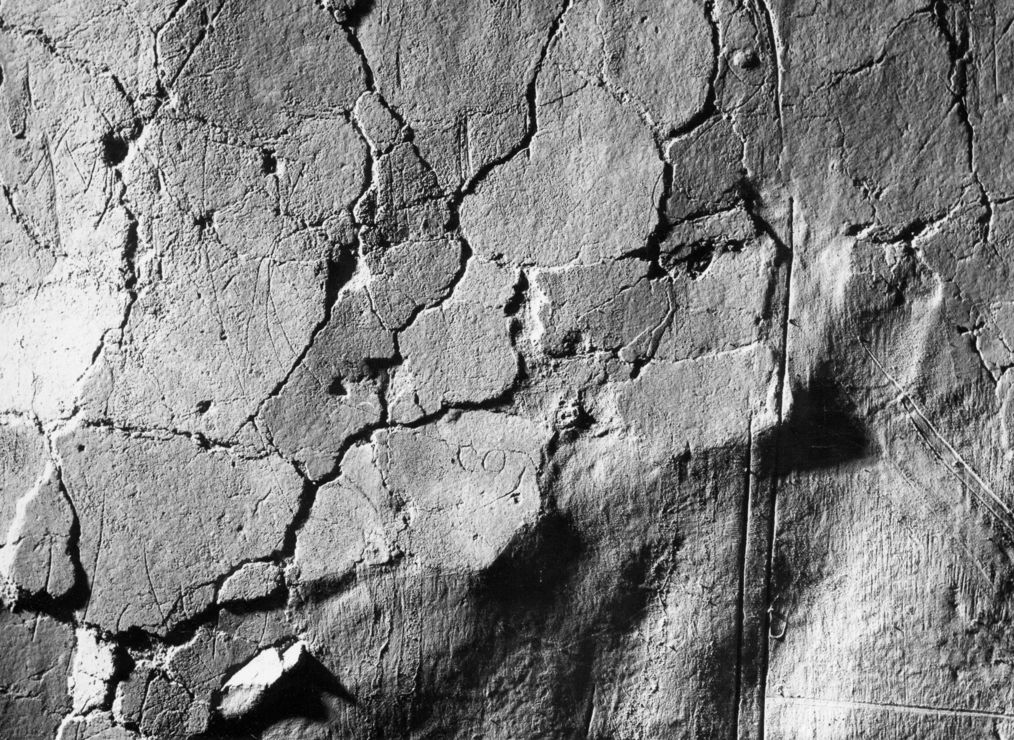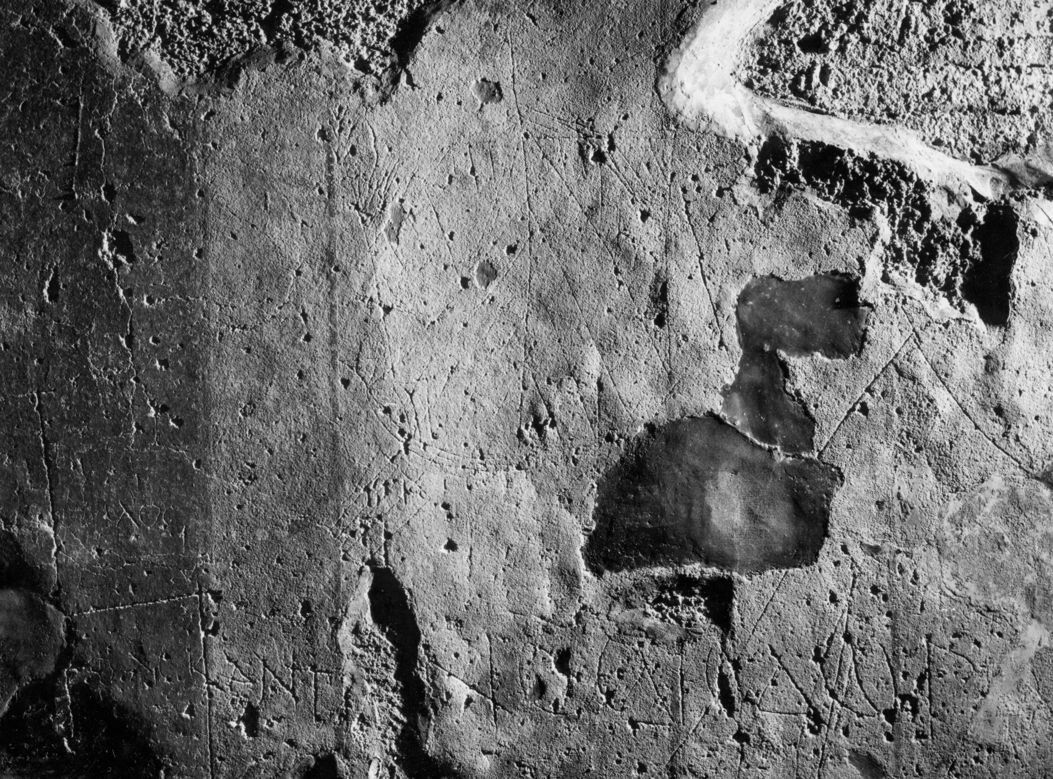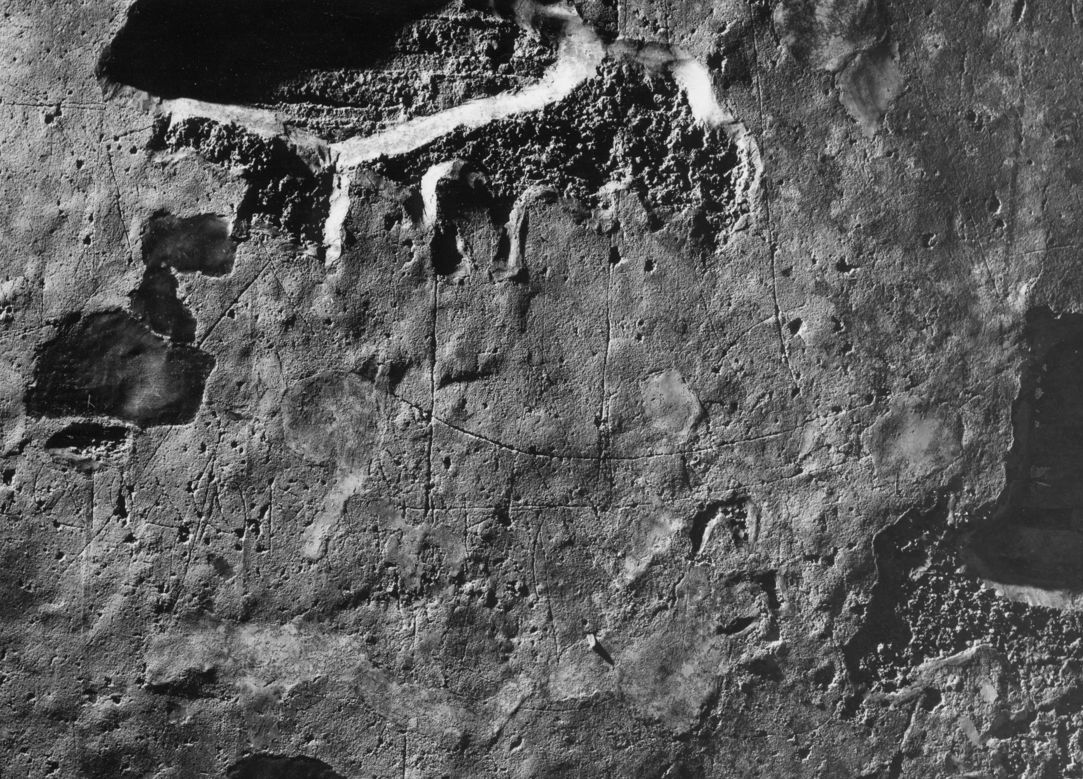Ships and skippers in graffiti
Returning now to Ostia and Portus, we can have a look at the impact of the ships and the skippers on these cities. Ships and guilds of skippers (navicularii) are documented very well on the Piazzale delle Corporazioni (Square of the Corporations), behind the theatre. Cargo ships and tow boats with people at work can be seen on many reliefs. This evidence is discussed extensively as separate topics. Here we will have a look at some graffiti.
The most informative graffiti were found in the House of the Priestesses, one of the apartments in the Garden Houses-complex. On a wall of the organizing room (medianum) is the prow of a ship. The most interesting graffiti are in a corridor. On one wall is an unfinished drawing of a ship, on the opposite wall is a group of graffiti. Here we see a drawing of three ships, a complete one in the centre (about 32 cm. long), flanked by two unfinished drawings or mere sketches.

Three ships and text. House of the Priestesses, corridor 10, north wall. Image: SO XV, fig. 167.4.
Above the central ship is the text:
|
MAGISTER MENOPHILVS MENOPHILVS GVBERNATOR EVSEBIAS |
Captain Menophilus, Menophilus the steersman, of [the ship] Eusebeia. |
The ship below the Latin text is clearly a tow boat, very similar to the ship on the relief from Salerno that we saw earlier. The mast has small protuberances, and has been lowered. The Greek name of the ship, Eusebeia, corresponds with the Latin Pietas, "Devotion". Similar Greek names of ships are Eutuchia ("Success"), Homonoia ("Concord"), Prothumia ("Readiness"), and Boetheia ("Aid"). The graffiti were made by Menophilus, who says that he is both captain and steersman (or was the steersman his son?). He must have come from the eastern half of the Empire, because he also wrote his name in Greek, twice: MHNOΦIΛOC. One name is almost two meters long, the other a little over one meter! On top of the second text is an unfinished drawing of a ship.

Text and a ship. House of the Priestesses, corridor 10, north wall. Images: SO XV, fig. 167.1 and (inset) 167.2.
Many other drawings of ships are depictions of cargo ships. Quite a few were found elsewhere in the Garden Houses, and perhaps also in the nearby House of the Painted Vaults (in the storage rooms; the place of discovery is not specified).

A ship. Garden Houses, unit 4, room 4b, north part of east wall. Photo: Jan Theo Bakker.

A ship recognizable by its two rudders. Garden Houses, unit 14, room 1, south wall. Photo: Robert Harp.

The rigging of the main sail of a ship, with the main mast and the yard.
Garden Houses, House of the Yellow Walls, room 6, east wall. Photo: Robert Harp.
 |
|
 |
 |
|
Top: ship with main sail, bowsprit sail, flag in top; two small ships in the background. Bottom left: ship with a concave bow. Bottom right: ship with some sort of net on the stern and preceded by dolphins. Garden Houses, place of discovery not specified (in the storage rooms). Perhaps from the House of the Painted Vaults. Images: Langner 2001, nrs. 2202, 2009 and 2010. |
|

Detail of the ship acompanied by dolphins. Photo: ICCD E040831.
Two drawings in the House of the Charioteers are of special interest. The first has a depiction of a head on the bow, presumably of a deity. On the second is the beginning of a word, perhaps corbita, a name used for certain cargo ships.

A ship with the head of deity on the bow. House of the Charioteers, room 32, north wall. Photo: Francis Brenders.

The bow of a ship with the text COR[bita?]. House of the Charioteers, room 32, south wall. Photo: ICCD N005254.
More drawings of ships are found in the Shrine of the Three Naves, adjoining the House of the Charioteers. They are accompanied by some Greek graffiti. It has been suggested that the shrine was a meeting place of a guild of shippers or shipowners, practicing the cult of Dionysus.

A ship above the Greek names Abaskantianos and Diodoros.
Shrine of the Three Naves, west wall of apsidal cella. Photo: ICCD N005259.

A ship. Shrine of the Three Naves, west wall of apsidal cella. Photo: ICCD N005295.
A bit to the west, drawings were found in the Maritime Baths.

Maritime Baths, room 5, north-west wall. Photo: ICCD N014858.

Maritime Baths, room 5, north-west wall. Photo: ICCD N014862.
Two drawings, somewhat similar, were found in the House of Jupiter and Ganymede.

A cargo ship under full sail. Image: Calza 1920, 369-370, fig. 9.
House of Jupiter and Ganymede, room 31, south wall.

Part of a ship. House of Jupiter and Ganymede, room 33, north wall. Photo: Robert Harp.
Recently a drawing was found in the newly discovered Mithraeum of the Coloured Marble.

Mithraeum of the Coloured Marble, room 3, east wall. Photo: Massimiliano David.
In Portus a drawing was found in the Christian Basilica.

Portus, Christian Basilica, east perimetral wall, pier 127. Photo: Bordi 2013, fig. 5.10.
In most cases it is impossible to tell who made the drawings. Perhaps merchants, captains or crew members. Or perhaps residents of Ostia and Portus, who were involved in shipping, or were simply awed by the ships they saw on the river and in the harbour basins. In 1870 the presence was reported of a graffito in Portus, with which we can close this topic in an appropriate way. The graffito was found to the south of the basin of Trajan. Underneath a drawing of a ship about to unfurl its sails was written: Abi, "Go!".